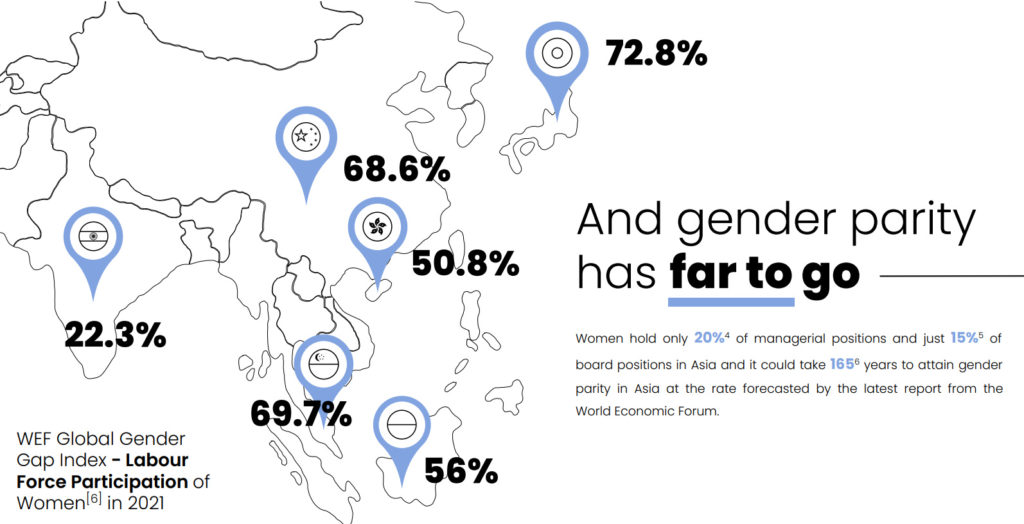SHEconomy founder and author, Benja Stig Fagerland, says gender equality is not a women’s issue but a business one. She calls for fixing the issue – not the women.
Frost analyst, Reenita Das, cited a Forbes article claiming that women who run tech companies provide a 35% higher ROI and 12% increase in revenue compared to men. But who’s counting?
On the consumption side, Winnie Chiu, a senior equity analyst for Indosuez Wealth Management in Hong Kong noted that the annual consumption expenditure of Chinese women alone is as high as 10 trillion yuan, which is close to the combined European retail markets of Germany, the United Kingdom and France. Again, who’s counting?

Elisa Mallis, managing director and vice president for APAC with the Center for Creative Leadership (CCL) says women hold up more than half of the economy – they take the lead in managing household budgets and spending.
“There is no doubt that businesses catering to female consumers will have an advantage. Meanwhile, the corporate purpose is no longer just about having a CSR programme on the side."
Elisa Mallis
She cited a CCL paper, Beyond Doing Good: 6 Mindset Shifts for Purposeful Leadership, which concludes that organisations who leverage the power of diversity are doing better as businesses.
Mallis says leaders must be to be purpose-driven and leverage gender parity as a competitive advantage.
The forces driving this acceleration towards SHEconomy
Mallis says more women are taking up executive roles, though it is still a smaller proportion as compared to men.

“Women’s appetite for career growth is bigger than we think, with a study by Nineby9 revealing that 79% of women had growth as their top career priority. Moreover, the rise of hybrid work has brought about more flexibility, allowing women to overcome common obstacles such as balancing between family and work to advance in their careers,” she continued.
She lamented that the pandemic has also affected women disproportionately, with more women dropping out of work or school due to additional caregiving responsibilities.
The short to medium-term impacts of the growth of the SHEconomy in Asia
Mallis opined that the growing consumption by female leaders will be a much-needed boost to the economy, with potentially US$4.5 trillion a year added to APAC’s collective GDP.
She posits that having leaders from diverse backgrounds will help shape better business decisions, as they bring about different strengths and perspectives.
“Women entrepreneurship will also have a long-term positive impact on women in Asia. For example, many femtech companies are improving access to healthcare services, especially for sensitive issues such as menstrual health,” she commented.
The role of government in the SHEconomy
Mallis says closing the gender gap in developing nations will have the greatest impact on improving the standard of living for future generations.
Women face two types of challenges in advancing their careers – pull factors which are intrinsic, and push factors which are systemic and create uneven playing fields. To fix the system, governments should take a stronger stance around issues like encouraging flexible maternity and paternity leave and supporting sponsorship for women.
Call to action for women leaders
According to the World Economic Forum’s leaders gender parity forecast, it could take another 165 years to attain gender parity in Asia if adjustments are not made.
“Female leaders need to look at push factors that are holding them back and enlist support from people of influence. It’s not just about creating a balanced, healthier, and prosperous society – when women are bold leaders, we are paving the way for our children and a better society,” she concluded.
Click on the PodChat player and listen to Mallis share her perspective on leadership and the role of women in driving the SHEconomy.
Before we begin our chat on the SHEconomy, tell us a little bit about the Center for Creative Leadership broadly and then how it is supporting current and next generation leaders, with a bit of emphasis on women.
- Do you agree with the real potential of a SHEconomy or is this just another marketing tactic to exploit?
- What are the forces driving an acceleration toward the SHEconomy?
- What will be the short- to medium-term impact on the growth of the SHEconomy in Asia?
- What should government do to contribute to the growth of the SHEconomy in Asia?
- What is your call to action for women leaders and those aspiring to lead as opposed to just following the herd?





